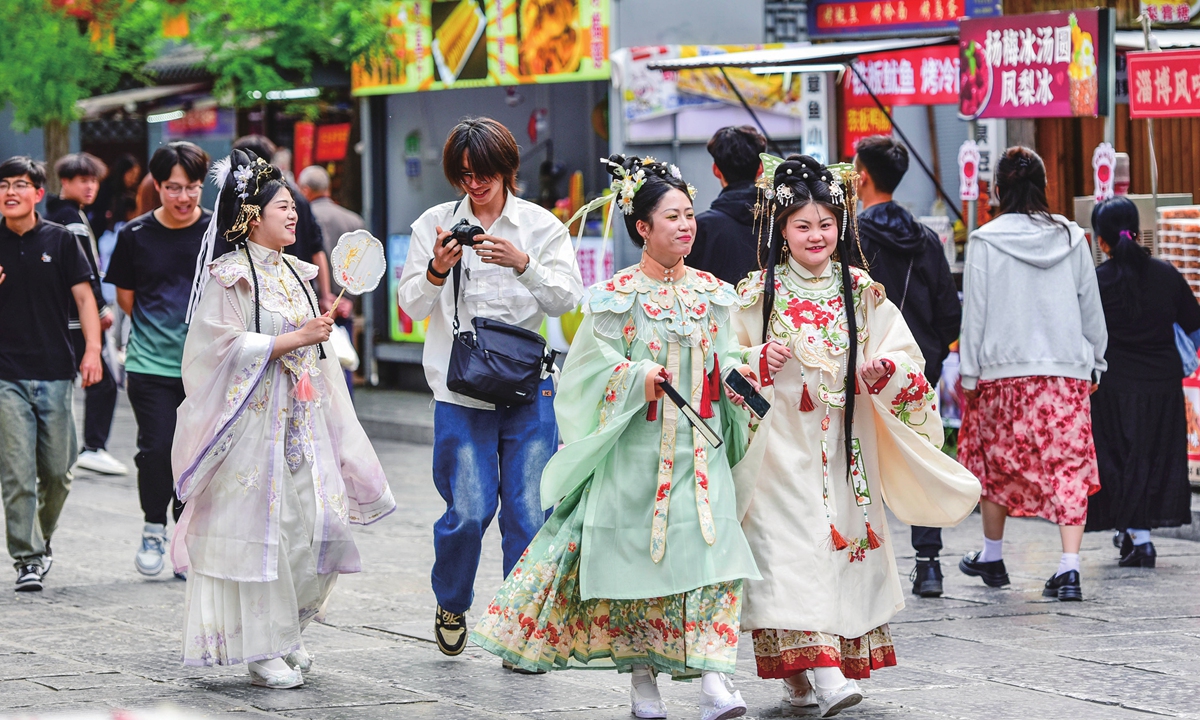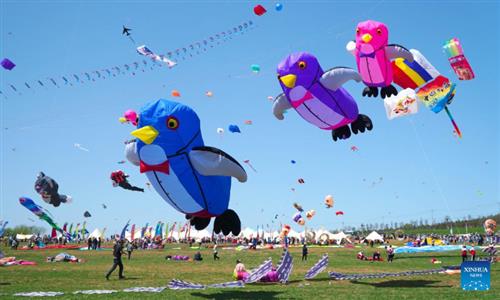ARTS / CULTURE & LEISURE
A fusion of cultural heritage and natural beauty
World Kite Capital

Weifang International Kite Festival Photo: VCG

Tourists in traditional clothes visit Qingzhou ancient town scenic spot in Weifang. Photo: VCG
Located in East China's Shandong Province, Weifang, known as the "World Capital of Kites," offers a fascinating blend of cultural heritage and scenic beauty. Come explore the city's rich history, from its ancient kite traditions to the modern-day attractions that draw tourists from around the globe.
The museum
At the heart of Weifang's identity is the Weifang World Kite Museum. Established in 1989, it is the first large-scale kite museum in China and is located in Kuiwen district of Weifang. Recognized as a prominent cultural site in the "World Capital of Kites," the museum's architecture is inspired by the traditional dragon centipede kite, with a roof designed to resemble a dragon in flight, underscoring its symbolic connection to kite flying.
This institution is more than just a museum, it's the heart of the global kite community, offering insights into kite evolution from a practical tool to an artistic symbol used in festivals and celebrations across China. Each exhibit delves into different aspects of kite craftsmanship, from the materials used to the intricate designs that depict everything from folklore to regional stories.
Visitors to the museum can explore various exhibitions that detail the history, craftsmanship and a wealth of kite-related materials, including photographs, calligraphy, paintings, and replicas that document the evolution of kite making over the centuries.
The museum is renowned not only for its collection but also for its educational and cultural role, particularly during the annual Weifang International Kite Festival, when kite enthusiasts from around the globe gather to celebrate and participate in kite flying competitions and exhibitions. This festival is a significant event that showcases the diversity and creativity of kite designs worldwide and underscores Weifang's status as a global center for kite enthusiasts, as well as a global kite ambassador.
The Weifang World Kite Museum is free to visit and is open from Tuesday to Sunday. Close to the Weifang train station, some visitors choose to make it their last stop in their visit to Weifang, storing their luggage at the coat check desk, which is very convenient for travelers.
A portal to the past
Fangzi town in Weifang, also known as Fangtze Eurotown, with its meticulously preserved historical architecture, provides a window into Weifang's complex colonial history. Once a hub of activity during the occupation periods, the town has been transformed into a vibrant site for cultural tourism.
The integration of historic preservation with modern cultural expressions creates a dynamic environment where the past meets the present. Visitors can wander through the town, admiring the architectural legacy and learning about the historical context that shaped the region.
Once one of the four major high-grade stations on the Jiaoji Railway, Fangzi Station played a pivotal role as a transportation hub between Jinan and Qingdao, two important cities in Shandong. Established in 1902, the station facilitated the development of Fangzi town, a community enriched by its railway and coal industries.
The town is remarkable for its well-preserved German and Japanese-style buildings, a legacy of historical colonial occupations. These include 103 German structures such as former military headquarters, hospitals, post offices, churches, and barracks, which together form a complete community architecture. Additionally, there are 63 Japanese buildings, including consulates, hotels, and banks.
Recognized for its cultural significance, this architectural cluster was designated as a key cultural relic protection unit by Weifang city in April 2000. In 2008, Fangzi district initiated conservation and development project, transforming the area into the "Fangtze Eurotown," named after the German pronunciation of Fangzi, to reflect the Rhine-style charm of the 1920s and 1930s.
Today, Fangtze Eurotown boasts a variety of cultural and historical attractions. It has evolved into a top film and television base in Shandong and a center for China-Germany cultural exchanges.
Natural escapes and beyond
Weifang's charm extends beyond its urban centers into the lush landscapes of Qingzhou, an area known for its profound historical significance and natural beauty.
Take Taihe Mountain for instance. It features natural scenic spots with picturesque valleys and cultural relics, making it a perfect spot for both trekking and historical exploration. And Old Dragon Lake is another spot not to be missed. The scenic area is renowned for its springs, pools, and historical buildings, providing a tranquil escape for nature lovers.
These natural attractions not only offer recreational opportunities but also provide a deeper understanding of the region's geographical diversity and its impact on local culture.
Efforts to enhance Weifang's tourism infrastructure have seen significant growth in the sector. The establishment of the Weifang Modern Kite Cooperative and other cultural enterprises aims to promote kite making not only as an art form but as a pillar of sustainable cultural tourism. This initiative includes the creation of a kite culture museum and an intangible heritage experience hall where visitors can engage directly with the kite-making process.
Weifang is well-connected by air, rail, and road, making it accessible to both domestic and international tourists. The city's transport infrastructure supports its status as a cultural and tourist destination, with facilities that accommodate large-scale events like the kite festival.
Looking ahead, Weifang is set to continue its trajectory as a center of cultural heritage and innovation. Meanwhile, plans for the establishment of new tourist attractions and cultural projects are underway, aiming to further integrate the rich history of the region with contemporary cultural practices and tourism.
The town is remarkable for its well-preserved German and Japanese-style buildings, a legacy of historical colonial occupations. These include 103 German structures such as former military headquarters, hospitals, post offices, churches, and barracks, which together form a complete community architecture. Additionally, there are 63 Japanese buildings, including consulates, hotels, and banks.
Recognized for its cultural significance, this architectural cluster was designated as a key cultural relic protection unit by Weifang city in April 2000. In 2008, Fangzi district initiated conservation and development project, transforming the area into the "Fangtze Eurotown," named after the German pronunciation of Fangzi, to reflect the Rhine-style charm of the 1920s and 1930s.
Today, Fangtze Eurotown boasts a variety of cultural and historical attractions. It has evolved into a top film and television base in Shandong and a center for China-Germany cultural exchanges.
Natural escapes and beyond
Weifang's charm extends beyond its urban centers into the lush landscapes of Qingzhou, an area known for its profound historical significance and natural beauty.
Take Taihe Mountain for instance. It features natural scenic spots with picturesque valleys and cultural relics, making it a perfect spot for both trekking and historical exploration. And Old Dragon Lake is another spot not to be missed. The scenic area is renowned for its springs, pools, and historical buildings, providing a tranquil escape for nature lovers.
These natural attractions not only offer recreational opportunities but also provide a deeper understanding of the region's geographical diversity and its impact on local culture.
Efforts to enhance Weifang's tourism infrastructure have seen significant growth in the sector. The establishment of the Weifang Modern Kite Cooperative and other cultural enterprises aims to promote kite making not only as an art form but as a pillar of sustainable cultural tourism. This initiative includes the creation of a kite culture museum and an intangible heritage experience hall where visitors can engage directly with the kite-making process.
Weifang is well-connected by air, rail, and road, making it accessible to both domestic and international tourists. The city's transport infrastructure supports its status as a cultural and tourist destination, with facilities that accommodate large-scale events like the kite festival.
Looking ahead, Weifang is set to continue its trajectory as a center of cultural heritage and innovation. Meanwhile, plans for the establishment of new tourist attractions and cultural projects are underway, aiming to further integrate the rich history of the region with contemporary cultural practices and tourism.

